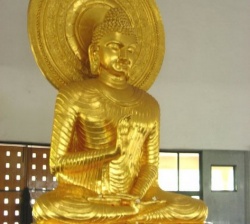Paribhogaka
paribhogaka (things he used), and uddesaka (reminders, i.e., representations, or images). The meaning of sariraka is eminently clear--here, Buddhists refer not only to the cremated ashes of the Buddha, but also to any other bodily relic, such as a hair, a tooth, a fragment of bone, or nails. Small caskets containing such sacred relics became an important focal point of Buddhist worship, and monuments and shrines said to contain such relics are found throughout the Buddhist world. The second category of relic, paribhogaka, includes objects like his robe, begging bowl, turban, and any chair or seat upon which he sat, among others. The most important of the paribhogaka objects is the bodhi tree at Bodh Gaya. But any place the Buddha visited, rested, or traversed would also be considered paribhogaka.
